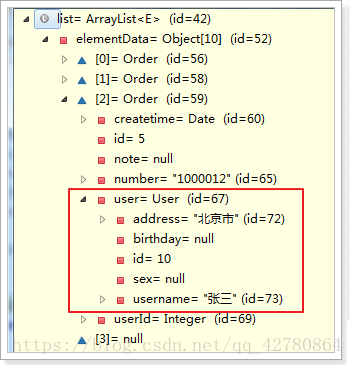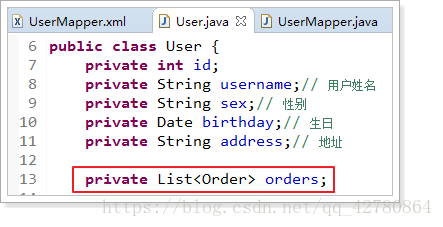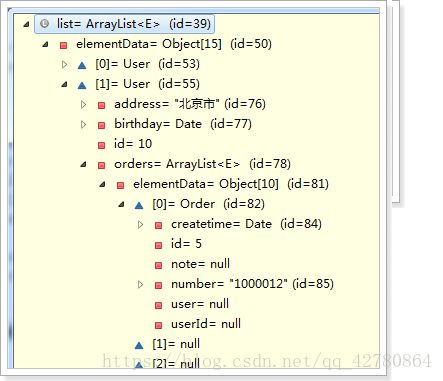resultMap的用法以及关联结果集映射
resultType
resultType可以把查询结果封装到pojo类型中,但必须pojo类的属性名和查询到的数据库表的字段名一致。
如果sql查询到的字段与pojo的属性名不一致,则需要使用resultMap将字段名和属性名对应起来,进行手动配置封装,将结果映射到pojo中
resultMap
resultMap可以实现将查询结果映射为复杂类型的pojo,比如在查询结果映射对象中包括pojo和list实现一对一查询和一对多查询。
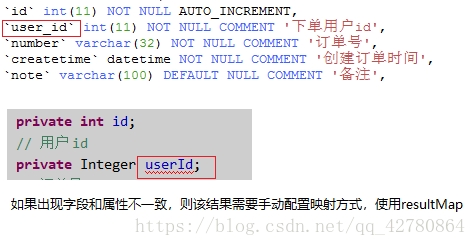
先在Mapper文件中,配置基本的sql语句
<select id="queryOrderAll" resultMap="orderResultMap">
SELECT id, user_id,
number,
createtime, note FROM `order`
select>配置resultMap标签,映射不同的字段和属性名
<resultMap type="order" id="orderResultMap">
<id property="id" column="id" />
<result property="userId" column="user_id" />
<result property="number" column="number" />
<result property="createtime" column="createtime" />
<result property="note" column="note" />
resultMap>结果就可以封装到pojo类型中
使用resultMap进行关联查询
一对一查询
一对一数据模型:订单用户
一个订单信息只会是一个人下的订单,所以从查询订单信息出发关联查询用户信息为一对一查询。如果从用户信息出发查询用户下的订单信息则为一对多查询,因为一个用户可以下多个订单。

改造pojo类
在订单类中添加User属性,User属性是一个引用类型,用于存储关联查询的用户信息,因为关联关系是一对一,所以只需要添加单个属性即可
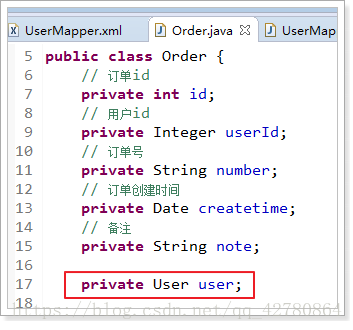
配置Mapper.xml配置文件
OrderMapper.xml
先使用id和result属性,映射order类的结果集,然后在使用association映射关联对象User的结果集
<resultMap type="order" id="orderUserResultMap">
<id property="id" column="id" />
<result property="userId" column="user_id" />
<result property="number" column="number" />
<result property="createtime" column="createtime" />
<result property="note" column="note" />
<association property="user" javaType="user">
<id property="id" column="user_id" />
<result property="username" column="username" />
<result property="address" column="address" />
association>
resultMap>
<select id="queryOrderUserResultMap" resultMap="orderUserResultMap">
SELECT
o.id,
o.user_id,
o.number,
o.createtime,
o.note,
u.username,
u.address
FROM
`order` o
LEFT JOIN `user` u ON o.user_id = u.id
select>- 测试
@Test
public void testQueryOrderUserResultMap() {
// mybatis和spring整合,整合之后,交给spring管理
SqlSession sqlSession = this.sqlSessionFactory.openSession();
// 创建Mapper接口的动态代理对象,整合之后,交给spring管理
UserMapper userMapper = sqlSession.getMapper(UserMapper.class);
// 使用userMapper执行根据条件查询用户,结果封装到Order类中
List list = userMapper.queryOrderUserResultMap();
for (Order o : list) {
System.out.println(o);
}
// mybatis和spring整合,整合之后,交给spring管理
sqlSession.close();
} 一对多查询
查询所有用户信息及相关订单。
修改UserMapper.xml配置文件
先使用id和result配置映射User类的结果,然后使用一对多关系的collection标签配置Order结果
<resultMap type="user" id="userOrderResultMap">
<id property="id" column="id" />
<result property="username" column="username" />
<result property="birthday" column="birthday" />
<result property="sex" column="sex" />
<result property="address" column="address" />
<collection property="orders" javaType="list" ofType="order">
<id property="id" column="oid" />
<result property="number" column="number" />
<result property="createtime" column="createtime" />
<result property="note" column="note" />
collection>
resultMap>
<select id="queryUserOrder" resultMap="userOrderResultMap">
SELECT
u.id,
u.username,
u.birthday,
u.sex,
u.address,
o.id oid,
o.number,
o.createtime,
o.note
FROM
`user` u
LEFT JOIN `order` o ON u.id = o.user_id
select>